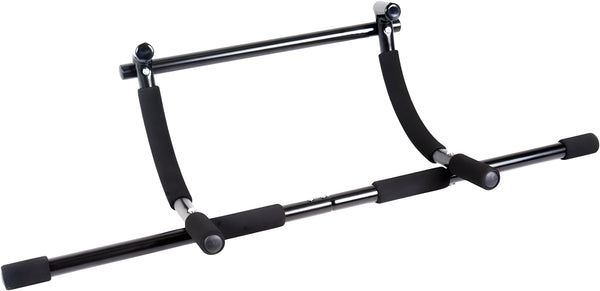Your Cart is Empty
November 17, 2023 3 min read
Pull ups are one of the most popular exercises and have been around for a long time. They involve lifting your body up and down using your arms, back and shoulders. Pull ups provide an excellent way to increase strength and build muscle mass in these areas.
Shop The Collection: Pull Up BarsPull ups provide many benefits for both men and women. Some of the most notable advantages include increased muscle mass, improved cardiovascular health, increased strength and flexibility, better posture, improved coordination and balance, and even improved mood.
 Shop The Gear: CAP Barbell Xtreme Doorway Pull Up Bar, $27.99 USD
Shop The Gear: CAP Barbell Xtreme Doorway Pull Up Bar, $27.99 USD
Pull ups can help to strengthen the muscles throughout the entire body, including the arms, shoulders, chest, back, and core muscles. This makes them one of the best exercises for overall body strength and conditioning. Additionally, pull ups work to build muscle size and mass, which can lead to more definition and improved physical appearance.
Pull ups also provide an excellent cardiovascular workout. Because they involve repetitive movements, they can get your heart rate up, resulting in improved cardiovascular fitness. This can help to reduce your risk of developing heart disease and other cardiovascular-related illnesses. If you’re looking for a great way to get your heart rate up and burn calories, pull ups are an excellent choice.
Pull ups also provide several mental health benefits. Regularly doing pull ups can help to improve your mood, as well as your coordination and balance. This can be especially beneficial for those who suffer from depression or anxiety, as it can help to boost their confidence and self-esteem. Additionally, because pull ups require concentration, they can help to improve focus and concentration.
When done correctly, pull ups provide a number of health benefits. But how do they actually work? Let’s explore the science behind pull up exercises.
First, let’s consider the muscles used during a pull up. The primary muscles involved are the latissimus dorsi, trapezius, rhomboids, pectoralis major, biceps brachii, triceps brachii, and erector spinae. These muscles are all necessary for proper form and technique when performing a pull up. When these muscles contract, they create the pulling motion that is necessary to lift the body up and down.
During a pull up, the muscles must go through a range of motion in order to complete the exercise correctly. The range of motion involves the scapula or shoulder blades, which must move up and down in order to properly engage the latissimus dorsi and other muscles. The arms must also flex and extend as the body moves up and down. Finally, the core muscles must be engaged to properly stabilize the body during the exercise.
In addition to the muscles used during a pull up, the exercise also requires the use of gravity. As the body is lifted up and down, the force of gravity helps to generate resistance. This resistance is what makes pull ups such an effective exercise, as it helps to build strength and muscle mass in the upper body.
In order to maximize the benefits of pull ups, it’s important to perform the exercise correctly. This means maintaining proper form and technique throughout the entire exercise. Here are a few tips to remember:
By following these tips, you can ensure that you’re getting the most out of your pull up workout. Additionally, it’s important to remember to warm up before performing any exercise, as this can help to prevent injury and ensure that you’re getting the most out of your workout.
Pull ups are an excellent exercise for improving overall body strength, building muscle mass, and providing a great cardiovascular workout. By understanding the science behind pull ups and following proper form and technique, you can maximize the benefits of this exercise. So grab a pull up bar and get started today!
Shipping Protection gives you peace of mind while saving you time and money.
Shipping Protection provides coverage for eligible orders that are lost or damaged in transit, or stolen after delivery has been confirmed by the carrier. MAGMA Fitness, through its partners, administers the protection program and may receive compensation for these services. Coverage is subject to the terms, conditions, and exclusions outlined in our Shipping Protection Terms & Conditions.